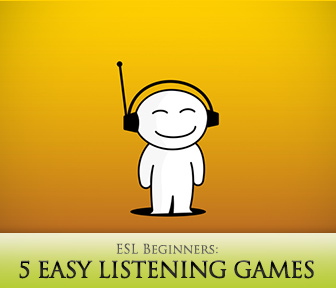5 Easy Listening Games for ESL Beginners


It’s crucial that students learn to listen to each other, ask for clarity, and interact with everyone in the class.
Following the tips below will aid students in opening up their ears and listening to each other naturally and effectively.
If the students come into your classroom and are accustomed to a friendly, safe environment they are much more likely to speak up and reach out to one another. It is the facilitator’s job to make sure the class is learning not just from you, but from each other. If they have trust and don’t feel inhibited, they will begin guiding each other naturally, stepping in to help each other, and get accustomed to different speaking styles and accents.
Creating an interactive, fun classroom atmosphere is one way to start students both speaking and listening. If you play a lot of games, get students out of their chairs and interacting, they really have no choice but to listen. Games are critical for this, but role plays are even better. Role plays are unscripted practice, so the students have to respond to each other in the moment. These are the best activities to get students listening to each other in an organic way. You could also include one-on-one interviews or mingling exercises which require students to report back to the group individually. It combines asking suitable questions, requesting clarification and reporting answers accurately. These activities produce wonderfully targeted listening practice while being fun and interactive.
Rounds are something that can be done easily and often with little to no effort or planning. They can be used to do comprehension checks, have students practice new grammar points or refresh old points they haven’t practiced in a while. The best thing about rounds is they combine speaking and listening and students must listen to one another in order to do the activity successfully. With rounds you have one student question the next student. After the student answers, he turns to the next student and asks her a question. It goes around and around as long as you see fit. You can alter rounds in so many ways that students will never get bored. During rounds is a perfect time to do corrections, guide students having trouble, and find teaching moments along the way. The best part is that students’ ears are wide open and they are actively listening to one another.
Creating exercises in which students correct each other can be tricky, but if you set it up right, everyone wins. Create a game where all students get corrected in some way, so that there isn’t any awkwardness about singling each other out. One way to do this is to give one student a cue to begin speaking on a topic, and the class is supposed to stop the student any time they hear a mistake. Secretly tell the student speaker to purposely make a few mistakes to see if the class catches them.
Giving students opportunities to teach a small piece of a lesson can be especially fun and enlightening. Make sure that all students get a chance to do this, and give them time in advance to prepare. When students get up in front of the class to “play the teacher” you’ll want to provide perimeters for them to follow and assign them a task that they are comfortable carrying out. Some good tasks for student teachers are: setting up a game or activity, reviewing a grammar point that they know well, introducing their own warm-up activity, or directing the reporting portion or wrap-up of an activity.
Incorporating the above tips into your regular classroom activities will enhance students’ classroom experience and get them listening on a whole other level.